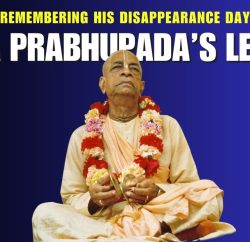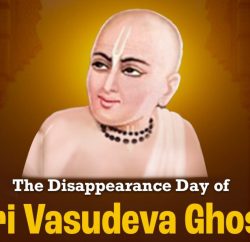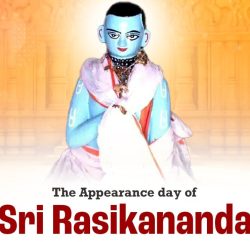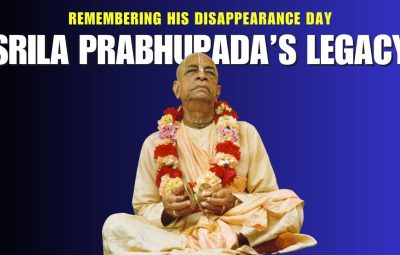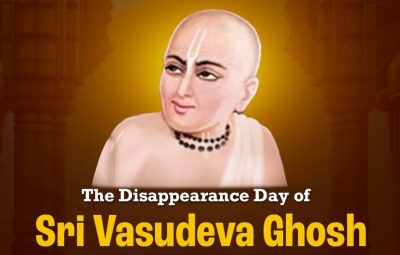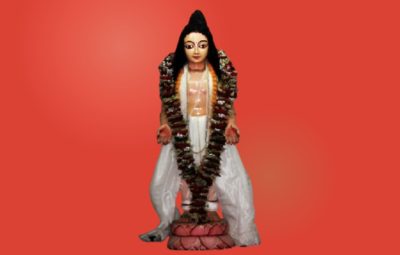Sri Srinivasa Acharya was born in 1530 AD, on the full moon day of the month of Vaishakh, in the village of Cakhandi, in the district of Nadiya. His father, Gangadhara Bhattacharya, was a Brahmin of the Rarha class. The Bhakti-ratnakara describes the event as follows:
When Mahaprabhu took sannyasa in Katwa, Gangadhara Bhattacharya was overcome with grief and began to cry constantly while calling out the names “Ha Chaitanya! Ha Chaitanya!” When other devotees saw him intoxicated in divine love for Mahaprabhu, they nicknamed him Chaitanya Dasa, a name that stuck with him for the rest of his life.
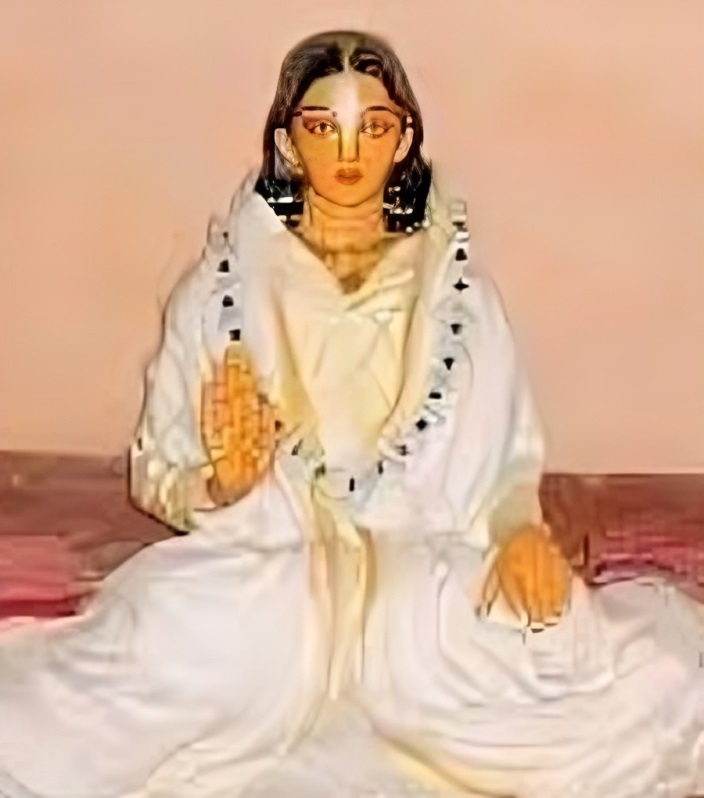
Chaitanya Dasa had no desire for the things of this world, but one day he suddenly felt a strong wish to have a son and told this to his wife, Lakshmipriya. She responded by telling him to immediately go to Puri to ask Mahaprabhu for his blessings. The couple left for Puri, stopping
for a few days at the house of Balarama Vipra, Lakshmipriya’s father, in Jajigrama. When they arrived in Puri, Chaitanya Dasa and his wife paid their obeisances to Mahaprabhu, but before they could speak, the Lord himself said, understanding their desire, “Jagannath Deva will surely fulfil all your desires.”
The other devotees were curious about what desire Mahaprabhu was talking about, and they asked his servant Govinda. But before he could say anything, Mahaprabhu called Govinda and gave him the answer: “Chaitanya Dasa desires to have a son. Indeed, his wife will give birth to a jewel of a son, who will be named Srinivasa. He will be the manifest form of my love and will be non-different from me. He will increase everyone’s enthusiasm for devotion. Through Rupa and others, I will bring scriptures into the world, and through Srinivasa, I shall distribute them.”
Once they had received Mahaprabhu’s blessing, Chaitanya Dasa and his wife returned to his home, and when the auspicious moment came, a son was born to them. Chaitanya Dasa immediately offered the child to Mahaprabhu.
Early education and travels:
Srinivasa Acharya was devoted to his parents. He was fortunate to hear both Mahaprabhu’s divine glories as well as Radha and Krishna’s Vrindavan pastimes from his father. The two of them would go into an ecstatic state as they discussed these transcendental topics. Srinivasa’s mother trained him in kirtan.
He studied grammar, literature and poetic theory from Dhananjaya Vidyavacaspati, and quickly acquired mastery of these subjects. Not long afterwards, Srinivasa’s father died. The loss of his devotee, father’s association greatly affected Srinivasa, but the other devotees made a concerted effort to console him and his mother in their grief.
Srinivasa took his mother and moved from Cakhandi to his maternal grandfather’s house in Jajigrama, where the villagers were overjoyed to see him. Shortly thereafter, he went to visit Narahari Sarkara in nearby Srikhanda. From Narahari, he learned that Mahaprabhu would shortly be ending his earthly pastimes. This news made Srinivasa determined to see the Lord before it happened. He quickly returned to Jajigrama and took permission from his mother to make the trip to Puri. He then joined the devotees on the annual pilgrimage. It was the fifth day of the waxing moon.
Before arriving in Puri, however, the news arrived that Mahaprabhu had indeed ended his lila. Srinivasa Acharya fainted at the news, and when he came back to consciousness, he decided to commit suicide. However, the Lord himself appeared to him in a dream and told him to complete his journey to Puri. Once in Puri, he again had a dream in which he saw Jagannath, Subhadra and Balaram, as well as Chaitanya Mahaprabhu with his associates. The incarnation of Mahaprabhu’s pleasure potency, Srila Gadadhara Pandit Goswami met him and both of them were immersed in an ocean of ecstasy. Srinivasa also met Raya Ramananda, Paramananda Puri, Sikhi Mahiti, Sarvabhauma Pandit, Vakresvara Pandit, Govinda, Sankara Pandit, Gopinath Acharya and received blessings from them all.
Srinivasa Acharya stayed for some time in Puri, hearing Srimad Bhagavatam from Gadadhara Pandit Goswami. Gadadhara then told him to return to Gauda. When Srinivasa returned, he heard that Advaita Acharya and Nityananda Prabhu had also disappeared. Once again, he was determined to end his life, but the two Prabhus appeared to him in a dream to assuage his grief and had him give up his intention.
When he arrived in Navadwip, Srinivasa was once again plunged into a morass of sorrow at the loss of Chaitanya Mahaprabhu. Vamsivadanananda Thakur saw him in this condition and approached Vishnupriya Devi and asked her to grant an audience to Srinivasa and bless him. Srinivasa Acharya was amazed to see the intense renunciation and deep faith of Mahaprabhu’s widow. While in Navadwip, he had a dream of Sachi Devi and received blessings from her, too. Srinivasa then wandered throughout Bengal, going to all the Sripatas of the associates of Mahaprabhu and Nityananda Prabhu, seeking their blessings. He visited Shantipur, Khardaha, Khanakula Krishnanagara, Srikhanda, etc., and met Murari Gupta, Srivasa Pandit, Damodar Pandit, Shuklambar Brahmachari, Gadadhara Dasa, Paramesvari Dasa, Jahnava Devi, Vasudha Devi, Virabhadra, Abhiram Thakur, Narahari Sarakara Thakur, Raghunandan Thakur. All these great personalities witnessed Srinivasa’s intense devotion and told him to go to Vrindavan. Srinivasa then went to his mother and asked her repeatedly for permission to make the trip, which she could not refuse when she saw his great eagerness.
Srinivasa arrived in Vraja:
Srinivasa then travelled through Agradvipa, Katwa, Mauresvara, Ekacakra to Kashi, Ayodhya, and Prayag. He spent a long time travelling and visiting all these holy places before finally arriving in Vraja. There he heard that Rupa Goswami, Sanatan Goswami, Kasisvara Pandit and Raghunath Bhatta Goswami had all disappeared. Raghunath Dasa Goswami, Gopal Bhatta Goswami and Jiva Goswami were still living, however. Srinivasa met all three of them and received their blessings. He was initiated by Gopal Bhatta and took instruction in the Vaishnava scriptures from Jiva. In great affection for Srinivasa, Jiva commended him to his deities, Radha Damodara. Srinivasa met Raghunath Dasa and Krishna Dasa Kaviraj in Radha Kunda and received their blessings. One day, Sri Jiva heard Srinivasa explain a verse from Ujjvala-nilamani and was so impressed by his erudition that he bestowed the title “Acharya” upon him. Jiva also gave the titles “Thakur” to Narottama and “Shyamananda” to Dukhi Krishna Dasa. Jiva ordered Srinivasa to tour the sites of pilgrimage in the Vraja area with Raghava Goswami.
The return to Bengal:
After Srinivasa had attained mastery of the Gaudiya Vaishnava scriptures, Sri Jiva and the other Vaishnavas in Vraja ordered him, Narottama and Shyamananda to take manuscripts of these most valuable books back to Bengal in an ox-cart. It was a long and dangerous trip, but they were able to cover the greater part of the distance without any trouble. Upon arriving in the Hindu kingdom of Bana Vishnupura, they felt that the danger was over. However, the rumour had reached the capital of Vishnupura that a rich merchant was travelling to Puri with a valuable cargo of merchandise. The ruler of the kingdom led a gang of highwaymen, and when he heard that a cargo of great value was passing through his territory, he asked an astrologer to divine the truth of the rumours. The astrologer confirmed that this was indeed a cargo of great value. The king immediately sent a group of robbers to steal it, specifying that they should kill no one. The robbers first worshipped the goddess Candi, then sent out a spy who returned to tell them that everyone in the group accompanying the oxcart was sleeping in exhaustion after eating their night meal. The robbers thought that this was surely Candi’s mercy that a golden opportunity like this had come their way. They seized the oxcart and the books, thinking that they were gold and jewels, and turned them over to the king.
When Vishnupura’s king saw the large chest, he was delighted at the prospect of finding large amounts of valuables inside. How disappointed he must have been to see nothing but books inside! He turned to the astrologer and asked him how he could have made such a mistake. The astrologer answered, “I can’t understand it. Every time I made my calculations I came up with the same conclusion: this chest is full of priceless jewels! It is incredible, I don’t know why my calculations have gone wrong!”
The mere sight of the holy books had a purifying effect on the king, however, and he regretted having stolen them. Indeed, he desired to meet with the acharya of the books.
The next morning, Srinivasa, Narottama and Shyamananda awoke to find the chest of books missing. They searched everywhere, but when they failed to find any clue of the books’ whereabouts, they felt so depressed that they considered killing themselves. Some local villagers saw the distressed condition of the three Vaishnavas and immediately suspected the robber king, Vira Hambira. Srinivasa made some further investigations and was assured that he would be able to find more information from the king himself. The three Vaishnavas felt some hope and abandoned their suicidal intentions. Srinivasa Acharya decided to remain in Vishnupura in the hope of finding the books, but he sent Narottama to Kheturi and Shyamananda to Orissa.
The conversion of Vira Hambira:
While staying in Vishnupura, Srinivasa heard from a Brahmin named Krishnavallabha that Vira Hambira liked to listen to Srimad Bhagavatam and daily attended classes.
The next day, Srinivasa went with this Brahmin to the hall where the Bhagavatam classes were held. The Brahmin introduced Srinivasa to the king as a great Vaishnava, and the king indeed observed the characteristics of a great person in him and was attracted to him. The King expressed a desire to hear Srinivasa speak on the Bhagavatam and Srinivasa agreed, thinking that this might be a good opportunity to recover the books. So he started to give lectures on the Bhagavatam on a daily basis.
The King was enchanted by Srinivasa’s unprecedented explanations of the Bhagavatam in his sweet voice. Srinivasa Acharya primarily preached Mahaprabhu’s dharma through speaking on the Bhagavatam and kirtan, while Narottama and Shyamananda primarily used the medium of kirtan. The style of kirtan that these three acharyas used were named manohara-sahi, garanhati, and reneti.
Vira Hambira arranged for a secluded dwelling to be given to Srinivasa Acharya. One day, when he had the opportunity to find the king alone in his apartments, Srinivasa recounted the entire story of the journey from Vraja and the theft of the manuscripts. The King immediately confessed, showing great sorrow for his misdeed, and had the chest of books returned to its owner. In great relief, Srinivasa immediately sent messengers to Vrindavan, Narottama and Shyamananda with the good news. In the course of time, Vira Hambira and his entire entourage all took initiation from Srinivasa and dedicated their entire lives and wealth to him.
Srinivasa’s marriage:
After staying in Vana Vishnupura for some time, Srinivasa Acharya returned to his maternal grandfather’s house in Jajigrama. Then he set off on another tour of Katwa, Navadwip and other important towns in Bengal. Srinivasa respected Narahari Sarakara of Crekhaeoa greatly and was also very devoted to his saintly mother. When Narahari heard Srinivasa’s mother express her desire to see her son married, he gave him the order to do so. Even prior to receiving this order, Srinivasa had received the same command from Advaita Acharya in a dream. Though he felt somewhat ashamed, he realised that he could not ignore the wishes of Narahari, his mother and Advaita Prabhu. He thus agreed to get married and was wed to Isvari, the devoted daughter of Gopal Chakravarti of Jajigrama.
It is not always easy to understand the divine activities of Mahaprabhu’s devotees. Only someone who is totally surrendered to the Lord and his devotees can have access to their glories.
Srinivasa’s preaching activities:
Srinivasa Acharya started to teach the Goswamis’ books to his disciples in Jajigrama. One of his most important disciples was Ramachandra Kaviraj, the son of Srikhanda resident Ciranjiva Sena. Srinivasa gave Ramachandra the title kaviraja after hearing his poems. Narottama Thakur had a close friendship with Ramachandra Kaviraj and even wrote about it in one of his songs:
Daya koro Sriacharya Prabhu Srinivasa…..Please be merciful, Prabhu Srinivasa Acharya! Narottama Dasa begs for the association of Ramachandra.
When Shuklambara Brahmachari, Gadadhara Dasa, Narahari Sarkara and Dvija Hari Dasa all ended their earthly activities, Srinivasa Acharya once again felt overcome by grief and made another trip to Vrindavan. Once again, he met with Gopal Bhatta and Sri Jiva Goswamis, as well as with Bhugarbha and Lokanatha Goswamis, and these great devotees spoke to him encouragingly, reducing his feelings of loss. Ramachandra Kaviraj and Shyamananda Prabhu also joined Srinivasa in Vraja on this occasion.
When he returned to Gauda, Srinivasa joined in the festivities occasioning the anniversaries of the departure of Gadadhara Dasa in Katwa, Narahari in Srikhanda and Dvija Hari Dasa in Kancanagariya. From there he went to Budhari village, where Ramachandra Kaviraj and Govinda Kaviraj hosted him with great opulence.
Narottama Dasa Thakura had also left Vrindavan on Lokanatha Goswami’s orders, returning to his home in Kheturi. On the full moon day of Phalguna, he established the worship of six sets of deities in the temple there: Gauranga, Vallabhikanta, Vrajamohana, Sri Krishna, Radhakanta, and Radharamana. Srinivasa Acharya performed the installation ceremony and the first puja.
Jahnava Devi was also present at this great event. After the festival, she went on to Vraja with her entourage. Upon her return, she met with Srinivasa Acharya at Katwa and then went with him to spend some time in Jajigrama.
Srinivasa Acharya made another trip to Navadwip with Narottama and Ramachandra Kaviraj, performing the parikrama of the nine islands, each of which represents one of the limbs of devotional service.
When Raghunandan Thakur entered the nitya-lila, Srinivasa Acharya went to Srikhanda to help conduct the funeral festival in his honour. He returned with a heavy heart to Jajigrama, and from there went to see his disciples in Vana Vishnupura. He was received by the excited King and the other residents of the town. There, he received an order from Mahaprabhu himself in a dream to accept the hand of Gaurangapriya, the daughter of a certain Raghava Chakravarti. Raghava and his wife Madhavi had been searching for a suitable husband for their daughter with no success. They also received the order in a dream to give their daughter in marriage to Srinivasa. As a result, Srinivasa married for a second time.
The pure devotee has no other objective in life than to fulfill the desires of the Supreme Lord. They are thus ready to do anything if it pleases the Lord. None of their activities has the slightest hint of material desire in it. Srinivasa Acharya is the avesa incarnation of Mahaprabhu himself and his transcendental activities can only be described by someone who has received his special blessings.


